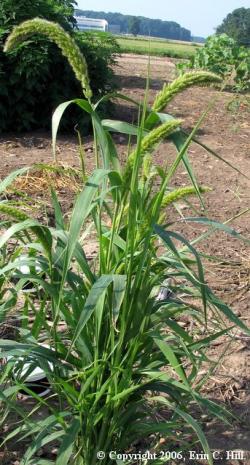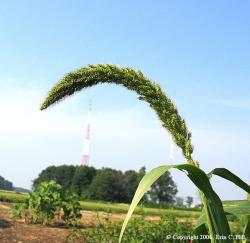Giant Foxtail
Giant Foxtail (Setaria faberi Herrm.)

Life cycle:
Summer annual. Emerges in the spring sets seed in late summer/fall and dies.
Emergence:
Giant foxtail emerges after common lambsquarters and the ragweeds. Ten percent emergence is observed between 150 and 300 GDD (base 48 F); 25 percent by 294 GDD (base 50 F). The period of emergence is lengthy.
Giant foxtail emerges from soil depths of less than one inch.
Seed:
Production Average: An average of 900 seeds are produced per plant (with a range from 500 to 2,500 seeds/plant).
Dispersal Mechanisms: None.
Longevity: Giant foxtail seed is moderately persistent. It takes 5 years for the seedbank to be reduced by 50% and about 30 years to deplete the seedbank by 99%. Our experience with giant foxtail has shown that it has very short seed longevity. Many seeds germinate the first year after seed is produced, and emergence in the second and third years is very limited.
Dormancy: The seed of giant foxtail is less dormant when the seed is located in the upper inch of the soil profile. As burial depth increases, seed dormancy decreases.
Competitiveness:
Corn yields were reduced by 13-14% from three giant foxtail plants per foot of row in Michigan. When giant foxtail is in a field, densities often exceed three plants per foot of row.
Preferred Soil / Field Conditions:
This weed grows best in compacted soils that have high levels of nitrogen. It also likes high soil phosphorus levels. Additionally, as pH increases, seed dormancy increases.

Management:
Biological
Predation: Giant foxtail seed lying on the soil surgace is a preferred food source for some ground (carabid) beetles and northern field crickets. Mice also consume giant foxtail seeds.
Decay: About 25% of giant foxtail seed decays in the first winter when buried 1-4" in the soil. Soil moisture and soil microorganisms are needed to decay weed seeds.
Mechanical
Tillage: Night tillage has no effect on giant foxtail emergence.
Rotary hoeing: Giant foxtail is more difficult to control than small broadleaf weeds. Rotary hoe before foxtail exceeds 1/4" in height.
Flaming: Grasses are more difficult to control with flaming than small broadleaf weeds.
Cultural
Crop rotation: 2 years of alfalfa in the rotation will control giant foxtail. Few seeds will persist to germinate when alfalfa is rotated out to the corn or another crop.
Planting date: Adjusting planting date has little effect on giant foxtail competition becuase foxtail has a lengthy period pf emergence and is is not a n early or late emerger.
Chemical
Application timing and effectiveness: Giant foxtail is easy to control in broadleaf crops. Controlling emerged foxtail in corn is more difficult.



 Print
Print Email
Email